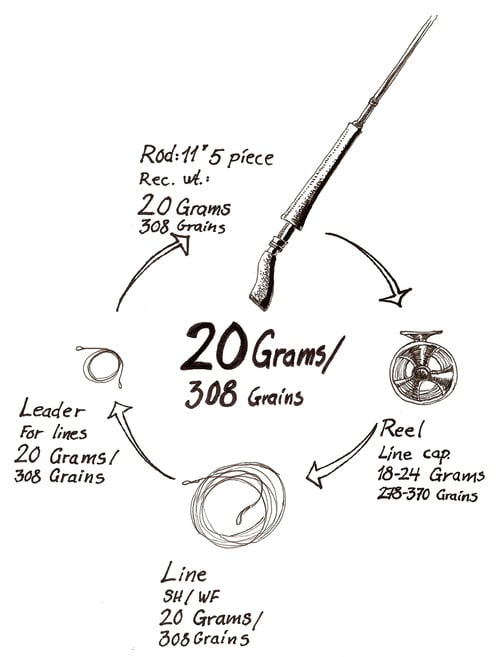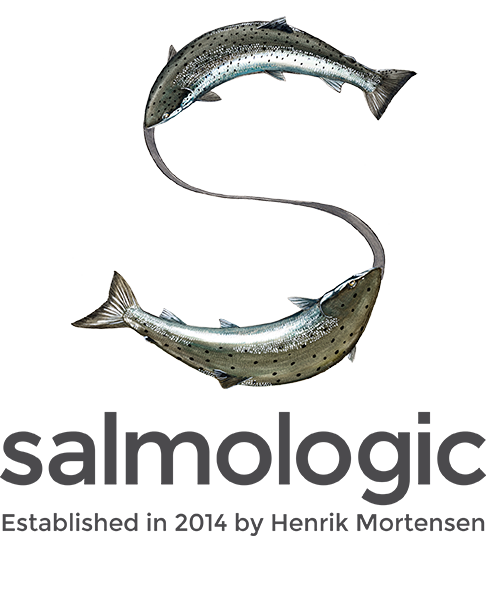SALMOLOGIC’S G&G RECOMMENDATION SYSTEM
Salmologic rods, reels, lines and leaders are recommended in grams and grains, thereby enabling the customers to make the right decisions when they are setting up their tackle for fishing.
The fact is that every line class has its own fly sizes and it is therefore important to purchase the right line weight according to the fly sizes you normally fish with.
Let me give you an example: If you normally fish for sea trout or salmon in a low glassy river and you use double hook sizes between 8 and 12, or with small cone head brass tubes, then a really good line weight to match those conditions and fly sizes (in my opinion), would be around 20 grams/308 grains.
To make sure your tackle is well-balanced, you would then need a rod that loads perfectly with 20 grams and a leader with the correct mass to turn over that fly size and, even more importantly, balance the speed between the upper and lower line in your loop going forward. Believe me, the leader is the most important part of your equipment and it is completely overlooked.
We, at salmologic, know the physics and the dynamics in a fly cast and how everything should be combined together. Therefore, we have decided against using the confusing AFTM system. Instead, we use what we call our G&G System – Grams and Grains System – because it makes sense. This is the only sure way that a fly fisherman has a chance to make the right decision when assembling his/her gear. Nothing gives an angler a better start in fly casting/fly fishing than the confidence that the tools he/she is using are actually perfectly “made to match” and balanced correctly.

SALMOLOGIC G&G SYSTEM VERSUS AFTM SYSTEM
You will notice that ALL of our products are recommended in grams and grains – i.e. you will not find any AFTM numbers in salmologic’s product line. We only use salmologic’s G&G System.
In all the years that I have been in the business, I have been forced to use the AFTM system to recommend lines, rods, reels and leaders due to the fact that this was the standard. I have always found this system completely misleading in all regards.
Throughout the past 25 years, I have held seminars all over the world and I have seen many anglers who were confused because they couldn’t figure out what, in general, was wrong with their casting. Upon examination of their gear, in 90% of the cases, the root of the problem was that their tackle wasn’t developed properly and/or it was unbalanced.
The reason why the AFTM system is misleading is basically because every fly tackle company has its own interpretation of this AFTM system. One of the major reasons for unbalanced tackle is due to poor guidelines from the manufacturer. Rather than using AFTM numbers alone, tackle companies should specify the precise casting weight for each rod that they design. By this I mean precise – not an approximation with intervals. A fly fisherman needs to know what actual weight their rod loads best with – not the AFTM number. It is not easy to match the lines and leaders to the rod with a misleading AFTM system. Normally the line doesn’t end up matching the rod, and it doesn’t matter if one is an incredibly skilled caster – nothing can compensate for that error/mismatch.
I have often been asked about AFTM numbers, such as in the following example:
A client asks, “Should I use a #7 line for this rod?”
I answer, “ Well, it is hard to confirm as there is no casting weight listed on your rod, only a number. I have no clue what the best casting weight for your rod is and also can’t know what the line weight might be on a #7 line, as those are very different from brand to brand. You’ll have to ask the manufacturer what they mean by a #7 line and a #7 rod.”
Early in my career as a gear developer, I tried to correct the chances of mismatch by adding a casting weight to the AFTM number and also listed this on the rods that I designed. I also added the line’s actual weight instead of an AFTM number on the fly line boxes. In my view, this little revolution brought us a step closer, because now the angler could actually see what casting weight he/she had to buy for his/her rod, which ensured that the tackle was well-balanced and adjusted according to the manufacturer’s/developer’s specifications.


